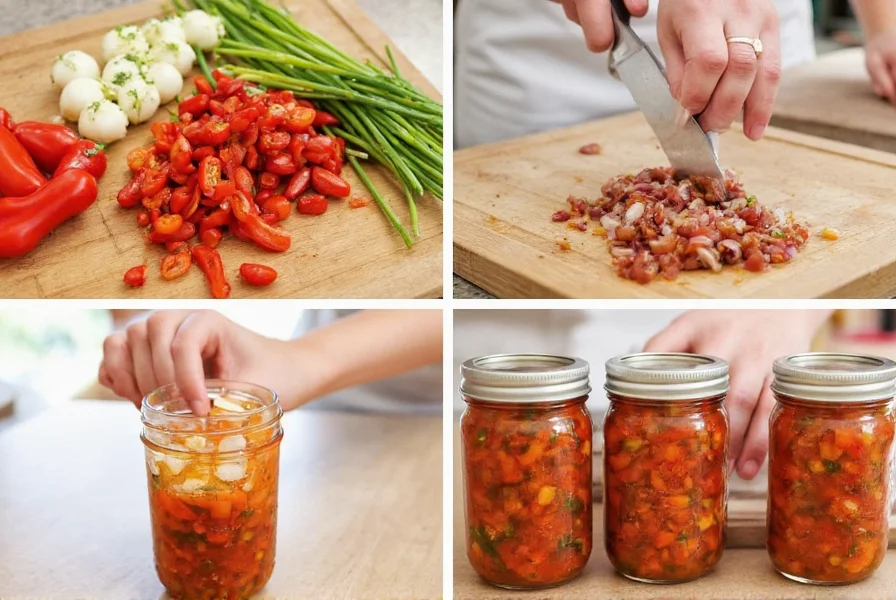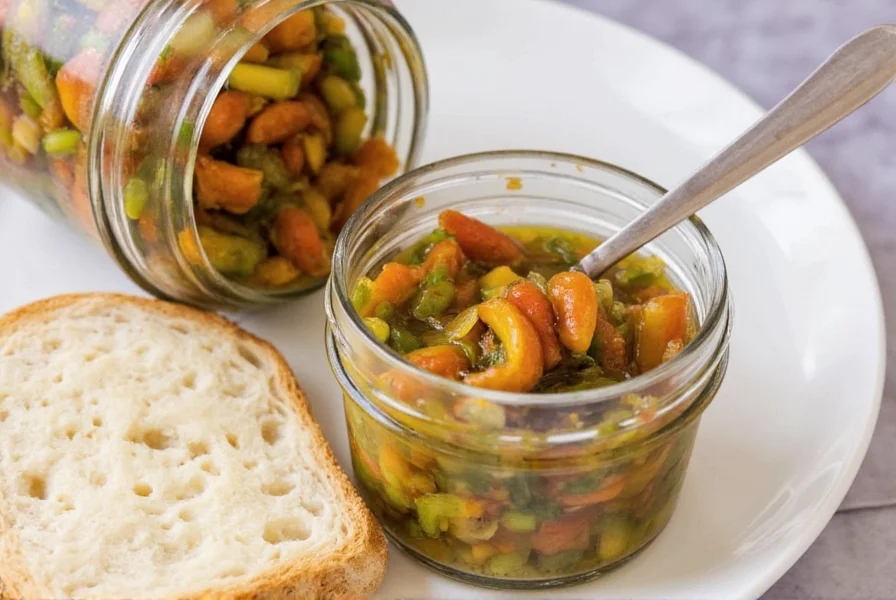Understanding the nuances of pepper onion relish can transform your culinary creations. This condiment stands apart from standard onion relish through the intentional incorporation of peppers, which add both flavor complexity and visual appeal. The balance between sweet onions and varying pepper varieties creates a dynamic taste profile that enhances rather than overwhelms dishes.
Core Characteristics of Quality Pepper Onion Relish
The texture and consistency of exceptional pepper onion relish should feature uniformly chopped ingredients that maintain their structure without becoming mushy. Properly prepared relish contains a balanced ratio of peppers to onions—typically a 60-40 split favoring peppers—which creates the ideal flavor harmony. The vinegar solution should be sufficiently acidic to preserve the relish while allowing the natural vegetable flavors to shine through.
When evaluating homemade or store-bought options, look for relishes with visible vegetable pieces rather than pureed textures. The color should remain vibrant—red peppers maintaining their rich hue, green peppers staying bright rather than dull. High-quality pepper onion relish avoids excessive sugar that masks the vegetable flavors, instead achieving sweetness through careful ingredient selection and balanced preservation techniques.
Popular Variations Across Culinary Traditions
Culinary traditions worldwide have developed distinctive takes on pepper onion relish. The Caribbean version often incorporates Scotch bonnet peppers for significant heat alongside sweet onions and tropical fruit elements. In contrast, American Southern-style relish typically uses milder banana peppers with Vidalia onions for a sweeter profile perfect for pulled pork sandwiches.
| Variation Type | Key Ingredients | Heat Level | Best Culinary Pairings |
|---|---|---|---|
| Classic American | Bell peppers, yellow onions, vinegar | Mild | Burgers, hot dogs, grilled chicken |
| Southwestern | Jalapeños, red onions, cilantro | Moderate | Tacos, grilled fish, nachos |
| Caribbean-Inspired | Scotch bonnets, sweet onions, mango | Hot | Grilled meats, rice bowls, jerk chicken |
| Southern Sweet | Banana peppers, Vidalia onions, sugar | Sweet-Mild | Pulled pork, fried green tomatoes, sandwiches |
Creating Homemade Pepper Onion Relish
Producing exceptional homemade pepper onion relish requires attention to ingredient selection and preparation technique. Start with fresh, firm vegetables—avoiding any with soft spots or discoloration. The chopping technique significantly impacts final texture; aim for 1/8-inch dice for optimal mouthfeel that holds together without being chunky. When combining ingredients, the vinegar-to-sugar ratio determines whether your relish leans sweet or tangy.
For a basic preparation method, combine 2 cups diced peppers, 1.5 cups diced onions, 1 cup vinegar, 1/2 cup sugar, 1 teaspoon mustard seed, and 1/2 teaspoon celery seed in a non-reactive pot. Bring to a gentle simmer and cook for 15-20 minutes until vegetables soften slightly while maintaining texture. Properly processed in sterilized jars, homemade pepper onion relish maintains quality for up to one year unopened, or three weeks refrigerated after opening.

Optimal Culinary Applications
The versatility of pepper onion relish makes it valuable across multiple meal categories. On sandwiches, it cuts through richness while adding moisture without sogginess—particularly effective with roast beef, turkey, and vegetarian options. When incorporated into burger blends before cooking, the relish distributes flavor throughout rather than sitting on top. For seafood applications, the acidity in properly balanced relish complements fish without overpowering delicate flavors.
Chefs increasingly use pepper onion relish as a base for compound butters, mixing one part relish with three parts softened butter. This creates an instant flavor boost for grilled proteins or roasted vegetables. Another professional technique involves folding relish into mayonnaise-based sauces at a 1:3 ratio for sandwich spreads with complex flavor dimensions. The relish's acidity also makes it an excellent component in marinades for tougher cuts of meat, helping to tenderize while adding flavor.
Storage Considerations and Shelf Life
Proper storage significantly impacts pepper onion relish quality and safety. Commercially prepared relish maintains peak quality for 12-18 months unopened in a cool, dark pantry. Once opened, transfer to the refrigerator and consume within 3-4 weeks. Homemade versions follow similar timelines but require careful attention to processing methods—water bath canning extends shelf life significantly compared to simple refrigeration.
Signs of spoilage include cloudiness in the liquid, mold growth, or off odors. Never consume relish from bulging containers, as this indicates potential bacterial growth. For extended freezer storage (up to 6 months), portion relish into ice cube trays, freeze solid, then transfer cubes to airtight containers—this method preserves flavor while allowing precise portioning for recipes.
Homemade vs. Store-Bought Comparison
While commercial pepper onion relish offers convenience, homemade versions provide superior flavor control and ingredient quality. Store-bought options often contain preservatives and stabilizers that affect texture and mouthfeel. The most significant advantage of homemade relish is customization—adjusting heat levels, sweetness, and vinegar intensity to match personal preferences or specific recipe requirements.
When selecting store-bought relish, read labels carefully for artificial colors or high-fructose corn syrup. Premium brands typically use simple ingredient lists with recognizable components. For special dietary needs, homemade preparation allows for sugar substitutes, reduced sodium options, or organic ingredient selection that may not be available commercially. The initial time investment in homemade relish pays dividends through superior flavor and the ability to create signature blends that elevate everyday meals.
Frequently Asked Questions
What's the difference between pepper relish and pepper onion relish?
Pepper relish contains only peppers as the primary vegetable ingredient, while pepper onion relish specifically combines both peppers and onions in varying ratios. The addition of onions creates a sweeter, more complex flavor profile compared to single-ingredient pepper relish. Most commercial pepper onion relishes maintain a 60-40 pepper-to-onion ratio for optimal flavor balance.
Can I substitute pepper onion relish for regular onion relish in recipes?
Yes, but with flavor adjustments. Pepper onion relish adds both sweetness from onions and varying heat levels from peppers, so substituting it for regular onion relish will introduce additional pepper flavor. For recipes requiring mild flavor, use sweet pepper varieties. When substituting in equal amounts, consider reducing other seasonings to account for the added complexity of pepper onion relish.
How can I reduce the heat level in homemade pepper onion relish?
To reduce heat in homemade pepper onion relish, remove seeds and white membranes from hot peppers before chopping, as these contain most capsaicin. Substitute hotter peppers with milder varieties like bell peppers or banana peppers. Increasing the onion-to-pepper ratio also balances heat. For immediate heat reduction, add a small amount of sugar or honey during cooking, which counteracts spiciness without altering texture.
What dishes pair best with spicy pepper onion relish?
Spicy pepper onion relish complements rich, fatty foods that benefit from acidic contrast. It pairs exceptionally well with grilled meats (particularly pork and beef), fish tacos, cheese boards featuring sharp cheddar, and bean-based dishes. The acidity cuts through richness while the heat adds dimension. For balanced pairings, serve spicy relish with cooling elements like avocado, sour cream, or cucumber to create flavor harmony on the palate.
How long does homemade pepper onion relish last in the refrigerator?
Properly prepared and stored homemade pepper onion relish maintains quality for 3-4 weeks in the refrigerator when kept in airtight containers. The vinegar content acts as a natural preservative, but freshness gradually declines over time. For optimal flavor, consume within two weeks. Always use clean utensils when serving to prevent contamination, and discard if you notice any off odors, mold, or significant texture changes.











 浙公网安备
33010002000092号
浙公网安备
33010002000092号 浙B2-20120091-4
浙B2-20120091-4